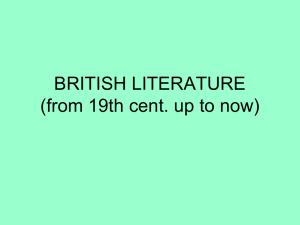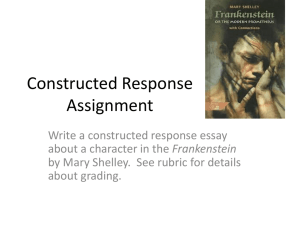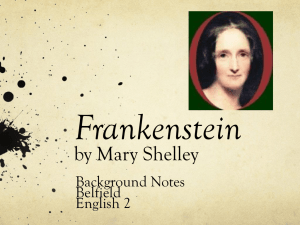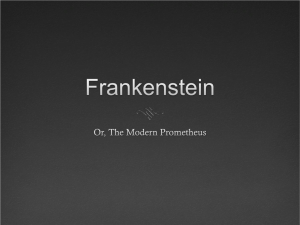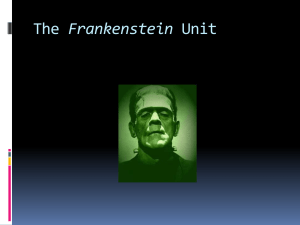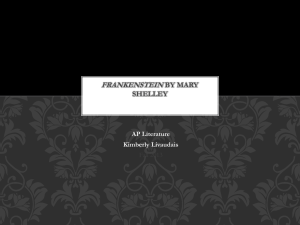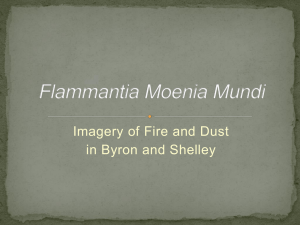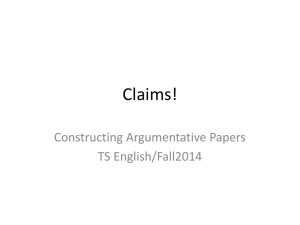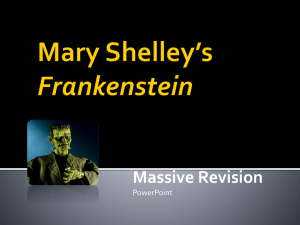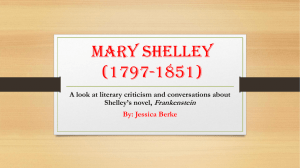Frankenstein Introduction
advertisement
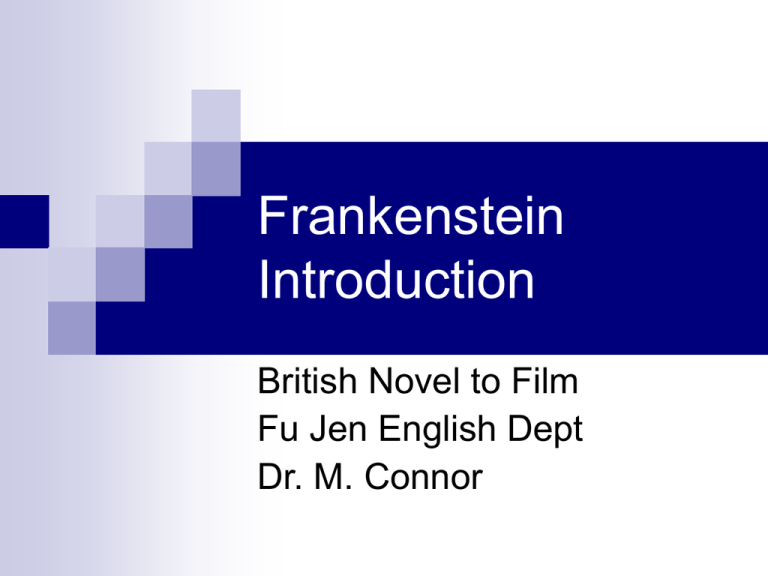
Frankenstein Introduction British Novel to Film Fu Jen English Dept Dr. M. Connor Introduction Mary Shelley’s 1818 novel Frankenstein is a complex blending of many different themes. Most people are familiar with the story, at least the version that has been passed down to us through the cinema versions, but many people are unaware of just how very complex it is. This week’s material Since I am assuming you are in the process of reading, I won’t be discussing plot or character much this week. This week’s materials will be devoted more to background and introduction. Intellectual stimulation At the time she was writing it, Shelley was intellectually stimulated--reading Romantic poetry with her brilliant husband Percy Bysshe Shelley and his friends and working through John Milton’s Paradise Lost among other great works. She was 18 years old. The Shelleys Source: http://www.nlm.nih.gov/hmd/frankenstein/IIA2.jpg Source: www.2idiotsinaboat.com/pilgrim/media/0830.jpg Year of tragedy But she was also grieving the loss of her first child, a terrible tragedy for any one. But there was more to come. Her halfsister Fanny Imlay committed suicide in the following fall, when she was still writing the novel, as would Percy’s deserted and unhappy wife, Harriet. Lake Geneva Mary Shelley was only 18, far from home, on the banks of Lake Geneva, Switzerland, during one of the worst summers on record. It was cold and rainy that summer, and Geneva is no place to be under those conditions! Life in Geneva I’ve had the great good luck to live in Geneva while teaching this novel, partially set in that city. One summer course I spent doing this book and the film versions of it was another horrible summer--wet, cold and full of thunderstorms bouncing off the mountains that encircle Lake Geneva-the Alps and the French Juras. Oppressive atmosphere After reading the book together and watching the films, my class and I felt we had some additional insights into what went into the book. While one of the prettiest places on Earth, Geneva in the cold and rain can be quite spiritually oppressive. Even with electric lights, a Genevan sunset is lovely. The Juras are in the background. The Italian Alps outside of Geneva. These are the mountains Shelley was thinking of when she was writing her novel. June 16th As all the introductions to the novel tell you, its inception came on a very special night. Thanks to the torrential rains, the Shelleys could not return to their own villa, so they had to spend the night at their friend Lord Byron’s villa, Villa Diodoti. The house party included Mary’s stepsister, Claire Clairmont, Lord Byron, and John Polidori, Byron's physician. Source: http://www.ualberta.ca/~dmiall/Gothic/Diodati.jpg The night on film This house party is immortalized in Ken Russell’s strangely compelling Gothic (1986), which gives a fictionalized account of the evening, with Natasha Richardson as Mary Shelley, Julian Sands as Percy Shelley and Gabriel Byrne as Byron. A poster for the film Gothic. It’s a strange film, but I recommend it. A little violent, though. The head on the bottom left of the poster is Dr. Polidori. To the left are the Shelleys, and the final picture on the bottom is Lord Byron. Photo source: http://www5.airnet.ne.jp/a shiato/POLITICS%20of% 20AUTHOR/KEN%20RU SSELL/GOTHIC/GOTHIC .JPEG The Evening’s Challenge After giving themselves a good scare reading a collection of German ghost stories, The Fantasmagoriana, aloud, they set each other a task. Each would write a horror story for the entertainment of the rest. Shelley wrote a now-forgotten story, Byron wrote a story fragment, and Polidori began the "The Vampyre", the first modern vampire tale, which he later finished and published in 1819. What of Mary? And poor Mary had a terrible time. She couldn’t get started. But a few days later, she had what she called “a waking dream:” “I saw the pale student of unhallowed arts kneeling beside the thing he had put together. I saw the hideous phantasm of a man stretched out, then, on the working of some powerful engine, show signs of life...His success would terrify the artist; he would rush away...hope that...this thing...would subside into dead matter...he opens his eyes; behold the horrid thing stands at his bedside, opening his curtains... (http://www.kimwoodbridge.com/maryshel/sum mer.shtml) She had the beginning The next morning Mary realized she had found her story and began writing the famous lines that open Chapter Four of Frankenstein - "It was on a dreary night in November”. Source: http://www.olemiss.edu/courses/engl205/frankart7.html Intense Reading Program Shelley was doing some heady reading that summer. In the days before the creation of her story she and Percy had been reading and discussing Samuel Taylor Coleridge’s “Christabel”, Germaine Necker, Madame de Stael's De l'Allemagne as well as Milton’s Paradise Lost. All of these influences can be found in the novel, but very few people who hear the name “Frankenstein” think of an intellectual novel. Separate PPT Please see the accompanying power point presentation on Milton’s Paradise Lost, as I think you probably need some background on the work. Quickly brought to Stage The first dramatization of Shelley’s novel came during her own lifetime. It was a three-act opera by R. B. Peake titled Presumption; or, The Fate of Frankenstein (1823). When Mary Shelley attended a performance of the play, she commented that she was “much amused and it appeared to excite a breathless eagerness in the audience” (quoted in Donald A. Glut, The Frankenstein Legend, Scarecrow Press, 1973, p 32). A second adaptation opened the same year, as did a trio of comedic versions. In 1826, new versions were staged in London and Paris. Film versions A quick search for “Frankenstein” on imdb.com brings up 102 hits, not including name matches! And that doesn’t include films like the recent Van Helsing in which Frankenstein’s monster plays a key role in the story. The Swiss Alps On the next slide is a map taken from my family’s personal homepages. It shows a trip we took when we lived there, but on the left side, you can see the Sea of Ice where the Creature and Frankenstein meet in book two. It’s written in German as Eisinmeer. Source: http://www.fillibabba.com/fun/english/Switzerland/index.html Romantic novel Of course, the novel is the most widely read Romantic novel, so quickly some background on the Romantics ”just in case”. Romantic period Usually designated as 1798-1832 In 1832 The Reform Bill carried in Parliament which changed many aspects of Victorian law and society as well as the death of Sir Walter Scott. Most of the major romantics had died or stopped creating by this date. Romanticism: A movement in literature, art, music and philosophy. Chiefly a reaction against the Age of Enlightenment and the Neoclassical movement and their rules about Reason, order, balance, rationality and intellect. In the pre-romantic period there was an upsurge in interest in medieval romances (the term romantic in either case has nothing to do with love). In medieval romances (ie: Tristan and Isolde and the Arthur tales), emphasized individual heroism and mysterious happenings. Think of the search for the Holy Grail or the story of the Fisher King From Bloomsbury’s Guide to English Literature. Romantics emphasized The individual The subjective The irrational The imaginative The personal The spontaneous The emotional The visionary The transcendental Characteristics of Romanticism are: Deepened appreciation of the beauties of Nature A general exaltation of emotion over reason An exaltation of the senses over the intellect A turning in upon the self and a heightened examination of human personality A preoccupation with the genius, the hero, and the exceptional figure A new view of the artist as a supremely individual creator, whose creative spirit is more important than strict adherence to formal rules and traditional procedures An emphasis upon imagination as a gateway to transcendent experience and spiritual truth A consuming interest in folk culture, national and ethnic cultural origins and the medieval era A predilection for the exotic, the remote, the mysterious, the weird, the occult, the monstrous, the diseased and even the satanic Frankenstein Most of these characteristics are central to the novel. But it transcends ”Romanticism” in some ways. It’s also considered the first science fiction novel. Photos Geneva is unbelievably beautiful, so I’m going to add some photos. You can see why it drew so many Romantic writers. The fountain in the lake wasn’t there in Shelley’s time. It’s late 19th century. View from the Old Town. http://www.geneve-tourisme.ch/?rubrique=0000000166 A view over the Old Town with St. Pierre’s Cathedral, which was there in Shelley’s day. See the beautiful mountains in the background. http://www.geneve-tourisme.ch/?rubrique=0000000166 A street in the Old Town showing the Swiss flag, the white cross, and the flag of Geneva, which is just as important to the Genevois. It shows the Eagle of liberty and the keys to the cathedral. Some wags say it’s half a chicken and the keys to the wine cellar! Genevois enjoy a French love of food! It may be in Switzerland, but it’s a French culture. Source: http://www.geneve-tourisme.ch/?rubrique=0000000166 La Salève, a mountain outside of Geneva, actually right over the French border. Frankenstein sees the Creature climbing up the mountain side. It’s about 680m high. Source: http://www.rando-saleve.net/ (in French, but nice pictures) La Salève from Lake Geneva. The Old Town, which would have been ”Geneva” in Shelley’s day, is the part on the lower right hand side. The part of the city on the top side of the photo was outside the city walls, but was developed as well.

